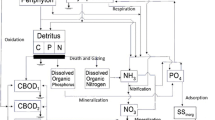Abstract
This paper proposes to analyze the dispersion of pollutants in aquatic systems, solving the advection–diffusion equation using numerical methods and fuzzy sets. For solution, numerical approximations were adopted, based on the finite element method for the spatial discretization and Crank–Nicolson for the time variable. The parameters of the equation were modeled taking into account aspects of multiple varieties of natural phenomena, based on fuzzy sets. The two-dimensional model resulted in the value of pollutant dispersion taking into account the flow velocity, in situations of prevailing winds in the region of a reservoir of Sao Paulo. According to the results, it was observed that the integration of the numerical methods and the fuzzy parameters is a potential instrument for environmental process analysis. The rule-based systems allowed a better design of the local natural phenomena. The spread of the plumes of pollutants was well defined by the model and the simulated scenarios are in agreement, from a qualitative point of view, with the local reality.







Similar content being viewed by others
References
Angeline R, Petrele M Jr (2000) A model for the plankton system of the Broa reservoir, So Carlos, Brazil. Ecol Model 126:131–137
Barco Escola Reservatorio de Salto Grande (2015) http://www.barcoescola.org.br
Brooks AN, Hughes TJR (1982) Streamline upwind/Petrov–Galerkin formulations for convection dominated flows with particular emphasis on incompressible Navier–Stokes equations. Comput Methods Appl Mech Eng 32:199–259
Carpenter SR, Caraco NF, Correll DL, Howarth RW, Sharpley AN, Smith VH (1998) Nonpoint pollution of surface waters with phosphorus and nitrogen. Ecol Appl 8:559–568
Chong OAG, Diniz GL, Villatoro FR (2005) Dispersal of fish populations in dams: modelling and simulation. Ecol Model 186:290–298
de Barros LC, Ferreira-Leite MB, Bassanezi RC (2003) The SI epidemiological models with a fuzzy transmission parameter. Comput Math Appl 45:1619–1628
Daniel TC, Sharpley AN, Lemunyon JL (1998) Agricultural phosphorus and eutrophication: a symposium overview. J Environ Qual 27:251–257
Dautray R, Lions JL (2000) Mathematical analysis and numerical methods for science and technology, vol 3. In: Spectral theory and applications. Springer, New York
Edelstein-Keshet L (2005) Mathematical models in biology, vol 46. In: Classics in applied mathematics. SIAM, Philadelphia
Espindola ELG, Leite MA, Dornfeld CB (2004) Reservatório de Salto Grande (Americana, SP), RiMa, São Carlos
Guitierrez-Estrada JC, Pulido-Calvo I, Bilton DT (2013) Consistency of fuzzy rules in an ecological context. Ecol Model 251:187–198
Heredia OS, Cirelli AF (2007) Environmental risk of increasing phosphorus addition in reaction to soil sortion capacity. Geoderma 137:426–431
Jafelice RSM, de Barros LC, Gomide F (2004) Fuzzy modeling in symptomatic HIV virus infected population. Bull Math Biol 66:1597–1620
Jafelice RSM, Bechara BFZ, de Barros LC, Bassanezi RC, Gomide F (2009) Cellular automata with fuzzy parameters in microscopic study of positive HIV individuals. Math Comput Model 50:32–44
Jafelice RSM, de Almeida CG, Meyer JFCA, Vasconcelos HL (2011) Fuzzy parameters in a partial differential equation for population dispersal of leaf-cutting ants. Nonlinear Anal Real World Appl 12:3397–3412
Janssen JAEB, Krol MS, Schielen RMJ, Hoekstra AY, Kok JL (2010) Assessment of uncertainties in expert knowledge, illustrated in fuzzy rule-based models. Ecol Model 221:1245–1251
Kardestuncer H, Norrie DH (1987) Finite element. McGraw-Hill, New York
Marchuck GI (1986) Mathematical models in environmental problems, vol 16. In: Studies in mathematics and its applications. North-Holland, Amsterdam
McCully P (2001) Silenced rivers: the ecology and politics of large dams, enlarged and updated edn. Zed Books, London
Meyer JFCA, Diniz GL (2007) Pollutant dispersion in wetland systems: mathematical modelling. Ecol Model 200:360–370
Montovani C, Poletti ECC (2012) O Impacto Ambiental na Bacia do Ribeirão do Pinhal—Município de Limeira-SP. Biomatemática (UNICAMP) 22:105–116
Murray JD (1989) Mathematical biology. Springer, New York
Okubo A (1980) Diffusion and ecological problems: mathematical models. Springer, Berlin
Ortega N, de Barros LC, Massad E (2003) Fuzzy gradual rules in epidemiology. Emerald 32:460–477
Pedrycz W, Gomide F (1998) An introduction to fuzzy sets. MIT Press, Cambridge
Poletti ECC (2009) Pollutant dispersion in reservoir’s systems: mathematical modelling using numerical simulation and fuzzy sets. Ph.D. Thesis, FEEC-UNICAMP, Campinas
Poletti ECC, Meyer JFCA (2009) Estudo da Dispersão de Poluentes com Parâmetros Fuzzy. In: Congresso Nacional de Matemática Aplicada e Computacional, Cuiabá
Soyupak AL, Mukhallalati D, Yemisen D, Bayar C, Yuteri C (1997) Evaluation of eutrophication control strategies for the Keban Dam reservoir. Ecol Model 97:99–110
Zadeh LA (1965) Fuzzy sets. Inf Control 8:338–352
Author information
Authors and Affiliations
Corresponding author
Additional information
Communicated by Geraldo Diniz.
Rights and permissions
About this article
Cite this article
Poletti, E.C.C., Meyer, J.F.d.C.A. Numerical methods and fuzzy parameters: an environmental impact assessment in aquatic systems. Comp. Appl. Math. 36, 1517–1528 (2017). https://doi.org/10.1007/s40314-015-0299-z
Received:
Revised:
Accepted:
Published:
Issue Date:
DOI: https://doi.org/10.1007/s40314-015-0299-z




